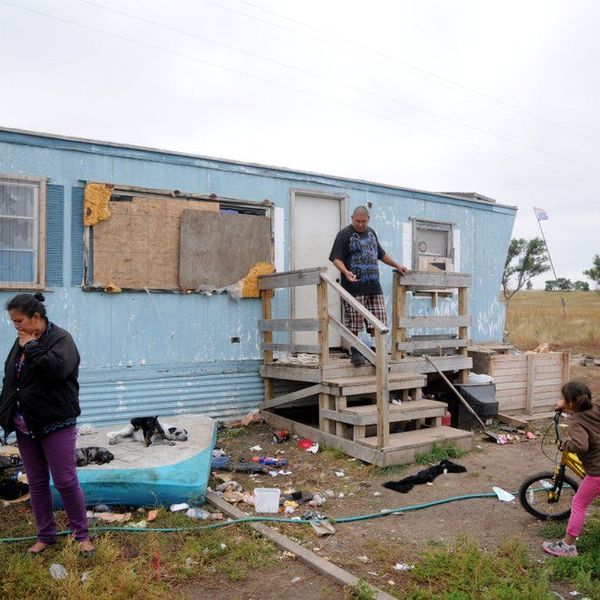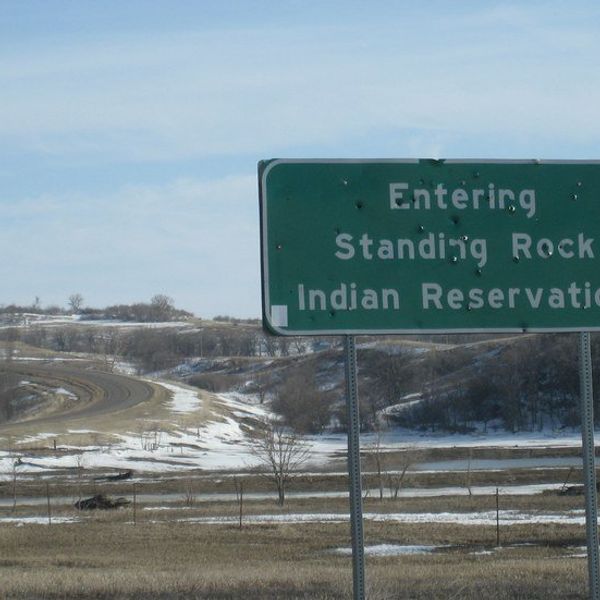The crowd of protestors thicken as members of other tribes come together to show their disapproval of the Dakota Access Pipeline. Over 300 different Native American tribes have come together to protest the Dakota Access Pipeline. While many people believe the Dakota Pipeline would have many benefits it will actually be bad for the those involved with the oil company, the environment, and the natives. The transporting of oil is leading to major conflicts. The environment is being harmed and leading to problems for animals as well as the Native Americans living in the region. Ways of life are being interrupted and valuable places are destroyed due to the want lack oil.
The Energy Transfer company have the hopes of transporting crude oil to another state to help lower the price of transporting the oil while also a finding safer and more direct way of transportation. The planned 1,172-mile pipeline will start in North Dakota and stretch through South Dakota, Iowa, and end in Illinois. Once it is in Illinois it will be connected to other pipelines to let 470,000 barrels of oil travel throughout the United States. The building of this pipeline will cost the United States $3.7 billion. This amount of money could be used for beneficial projects such as restoring cities, fixing damaged water pipes, funding charities, or even funding the United States education. The payment of the pipeline also comes not only from the company, but from Americans taxes. This job will provide anywhere from 8,000 to 12,000 jobs, but it is only temporary. Madison Park, a digital news producer with CNN, discovered the Dakota Access Pipeline will be used only for transportation and will not be used after the transportation of oil is complete unless it is needed to transport more oil in the future. There were other routes suggested to obtain this oil but all were turned down. To protect their land the Standing Rock Sioux tribes have been to court over the pipeline. In the court cases the Native Americans are being represented by an attorney with Earthjustice, a nonprofit environmental law firm, named Jan Hasselman. When asked about one incident where an ancient burial ground was bulldozed after a court case determining to not harm the site Hasselam states,” The shock and anguish felt by tribal members at this, and this abuse of the legal process, is really hard to describe” and so many other people feel the same. Many would think the discovery of the oil would be a good thing. However, the oil will eventually run out in an estimated twenty to thirty years. This lack of concern and compassion shown by the company towards the tribes is wrong and tragic.
The Dakota Access Pipeline is using underground construction to draw the oil from the ground to the pipes. The pipes both underground and above can show a possibility of leakage. If the pipes do leak they may continue to leak until it reaches a certain percentage. Joseph Erbentraut, a senior environmental reporter states, “All the pipelines’ leak detection systems are only set up to detect spills of greater than 2 percent [of their liquid].” The leak will lead to the Missouri river where not only the Tribe gets their drinking water but fish they consume as well. This water is also being drunk by other animals in the area leading to illness and sometimes even death if too much is consumed. The animals in this area of construction are in danger since not only is their food and water sources being destroyed, but their habitats as well. The animals in this region are used for recreational hunting, but is also a source of food. The land itself is being ruined due to it being dug up and cultivated for the pipes. These pipes are permanent and the land may suffer long term or even permanent damage from the pipes. To restore the land to its natural state it could take years and the animals may not return to the land. It is required by law under the National Environmental Policy Act that all environmental impact be considered before something like an airport, highways or any other federal activities are proposed. Per Dave Archambault II, the elected chairman of the Standing Rock Sioux Tribe, "We have laws that require federal agencies to consider environmental risks and protection of Indian historic and sacred sites.” These laws coexist with the National Environmental Policy Act which he states are being ignored by the Army Corps (Park). It is believed by the natives that these laws were not followed and that the earth is going to pay the price.
The natives will heavily be effected by the pipeline and they are determined to keep the land in its natural state due to all the trouble they have had gaining the land. The Standing Rock Sioux live on a reservation in South Dakota that was established April 29,1868. This is where they legally live due to Article 2 of the Treaty of Fort Laramie (United States 1868). However, over time the United States Congress continued to reduce the land after dividing the reservation into six different reservations. These reservations continue to operate under a constitution approved by the Tribal Council in 1959. The reservation(s) have been in the same region for 148 years and have followed all requirements and laws to keep their land. The Dakota Access Pipeline is going to influence the people on the reservations in many ways. Even though the natives are offered money for compensation by the company to move that is not enough. The people living on the reservations have employment opportunities that they may not have if they must move to a new place. The cost of moving can vary depending on the distance of the move and the house price, and in most cases, it is expensive and cannot be done in a short amount of time. Even if a sudden move is not expensive all the emotional attachment to a place can be hard or impossible to replace. Living in one place for many years and then asked to move can also cause unneeded work and stress. Along with their present lives is the rich history of the reservation.
Along the reservations are ancient burial grounds and land considered to be sacred by the natives. Along with burial grounds are places of cultural, religious, and historic significance that can never be replaced. There has been incidents of fires and places being bulldozed by the construction workers. After lawyers representing the Standing Rock Sioux Tribe filed evidence in court that document some of the Dakota Access pipeline’s proposed route, that would go through a sacred burial ground, the company began working on that very site. The company had bulldozers clearing earth as hundreds of Native Americans from different tribes rushed to the site to protect the burial grounds. The company’s security responded by attacking the Native Americans with dogs and pepper spray (Hasselman). There have been multiple incidents of protestors for the Dakota Access Pipeline being assaulted with video and photographic evidence provided. The assault should have never happened and the protestors have the right to peacefully protest due to the First Amendment of the United States Constitution. In interviews participants of the protest all mutually agreed they would do whatever needs to be done to protect the land.
The Standing Rock Sioux Tribe still have a long way to go before gaining their land back. As the protest gains attention, many other people are joining the protest in hopes of a great outcome for the natives. There are still many concerns for their environment and way of life. The hopes are to protect the historical and cultural sites as much as possible and gain more time. There are still court cases being held and protests are continuing daily. The Standing Rock Sioux Tribe also encourages anyone and everyone to join the protest in hopes of having the pipeline end once and for all.
Works Cited:
“About The Dakota Access Pipeline.” The Energy Transfer Company,
http://www.daplpipelinefacts.com/
Article 2 of the Treaty of Fort Laramie (United States 1868).
“Company Overview.” Company Overview, www.energytransfer.com/company_overview.aspx.
Erbentraut, Joseph. “The Dakota Access Pipeline Is An Example Of A Much Bigger Problem.” 19 Sept. 2016, www.huffingtonpost.com/entry/dakota-access-pipeline-protests-water_us_57d85a51e4b0aa4b722d12b1.
History.” Standing Rock, The Standing Rock Sioux Tribe, standingrock.org/history/.
Park, Madison. “5 Things to Know about the Dakota Access Pipeline.” CNN, Cable News Network, 31 Aug. 2016, www.cnn.com/2016/08/31/us/dakota-access-pipeline-explainer/index.html.





















